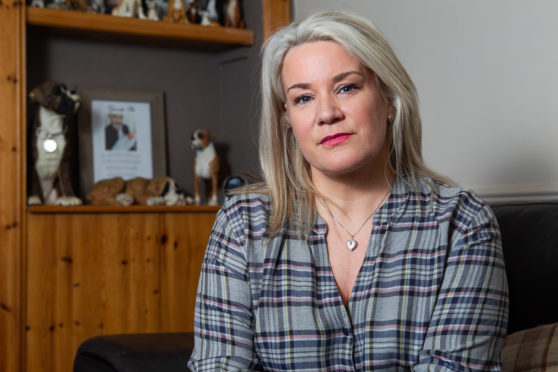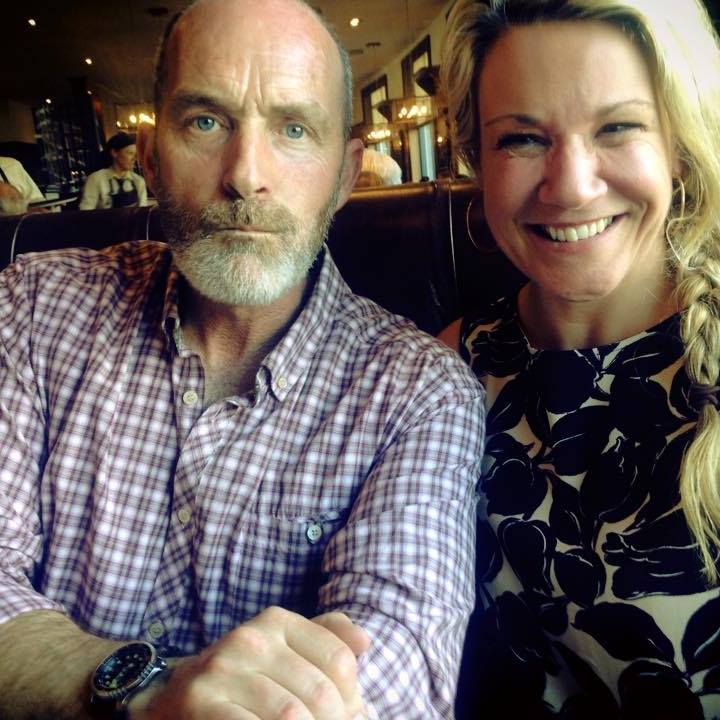
Keen golfer Pat Flynn was a fit and healthy man. Trips to the doctor were rare.
But one day, out of the blue, he was diagnosed with a relatively unknown condition – and less than a year later, it killed him.
Pat, from Fauldhouse, West Lothian, was just 52 when he passed away in May last year.
He had liver cancer, caused by haemochromatosis.
The genetic disorder causes the body to absorb too much iron.
Recent research suggests it affects one in 10 women, and one in five men.
Haemochromatosis is the UK’s most common genetic disorder.
The so-called “Celtic Curse” is particularly prominent in Scotland and Ireland. In fact, one in eight Scots is a carrier.
But, bizarrely, most people diagnosed have never heard of it.
Dad-of-two Pat was one such man – and sadly his haemochromatosis wasn’t detected until it was too late.
“Pat’s diagnosis came as a complete shock,” said Lorraine. “He was never sick.”
In September 2016, however, Pat experienced crippling abdominal pain. Lorraine rushed him to A&E.
“The doctors found gallstones and scheduled him in for surgery,” she said.
“But when the day came, he was on the operating table when the surgeon noticed his blood platelets were too low and wanted to reschedule.”
Haemochromatosis is a genetic disorder causing the body to absorb an excessive amount of iron from the diet: the iron is then deposited in various organs, mainly the liver, but also the heart, endocrine glands such as the pancreas, and joints.
Symptoms include chronic fatigue, joint disease and skin problems as well as leading to outcomes such as liver cancer and cirrhosis if left untreated.
Find out more about haemochromatosis at haemochromatosis.org.uk
Things settled back down and Pat had the surgery in March the following year.
Little did Lorraine know it was just the beginning of her husband’s health difficulties.
“The day after, when I picked him up, he said we needed to have a chat. It was serious,” said Lorraine.
“The doctor had noticed Pat had an enlarged liver, so referred him to a specialist.
“The next thing we heard was two months later when we were on holiday in Majorca.
“Pat’s consultant called to say the results of his blood tests were quite alarming. Ferritin levels are typically between 50 and 100 – but Pat’s were at 8,000.”
Pat had haemochromatosis, which can be treated by venesection.
The plan was regular blood removal until the levels decreased – but a few weeks later, his ferritin levels had shot up to 10,000.
In November 2017, Pat was diagnosed with primary liver cancer.
“There was no cure, no treatment…it was the worst-case scenario,” said Lorraine.
“It was like the world just caved in on us.
“We were brokenhearted.
“But I have never known a braver person.
“Pat never allowed himself to feel down about it.
“His attitude was just to take each day at a time and deal with whatever it threw at him over the next few months.
“The cancer went into his bones and they got so weak. One day he stood up and his hip broke.
“They weren’t sure about a hip replacement op because there was a risk of losing him during surgery, but they went with it. Thankfully he got home after a week in hospital – but he passed away four days later.”
Gran-of-two Lorraine, 49, believes haemochromatosis, which can be picked up in a simple blood test, should be tested for as standard.
Along with son, Ryan, 30, and daughter Shaunagh, 26, she is keen to raise awareness to help others.
“It’s something the public and, indeed, doctors could be better educated in,” said Lorraine.
“Before all this, we had never heard of haemochromatosis.
“Pat didn’t have any symptoms which made it difficult to spot – and I’d imagine the same is true of other people.”
As it’s a genetic condition, Shaunagh and Ryan have been tested.
“Shaunagh carries the gene but Ryan has haemochromatosis and has to have venesections,” said Lorraine.
“I suppose the positive is that at least we know Ryan has it and he can be monitored.
“It’s just a shame it was too late for Pat.”
Friends of the family have organised an event to generate awareness and raise funds for the Haemochromatosis UK charity.
It will be held in May at Greenburn Golf Club, Fauldhouse, where Pat played from his early years.
Visit haemochromatosis.org.uk. Search for Pat Flynn Charity Texas Scramble on Facebook
KEEN golfer Pat Flynn was a fit and healthy man. Trips to the doctor were rare.
But one day, out of the blue, he was diagnosed with a relatively unknown condition – and just five months later, it killed him.
Pat, from Fauldhouse, West Lothian, was just 52 when he passed away in May last year. He had liver cancer, caused by haemochromatosis.
The genetic disorder causes the body to absorb too much iron, and can lead to serious complications if left untreated.
Recent research suggests it affects one in 10 women, and one in five men. Haemochromatosis is the UK’s most common genetic disorder.
Nicknamed the Celtic Curse, it’s particularly prominent in Scots. In fact, one in eight Scots is a carrier.
But bizarrely most people diagnosed have never heard of it.
Dad-of-two Pat Flynn was one such man – and sadly his haemochromatosis wasn’t detected until it was too late.
“Pat’s diagnosis came as a complete shock,” Lorraine said. “He was never sick.”
In September 2016, however, Pat experienced crippling abdominal pain. Lorraine rushed him to A&E.
“The doctors found gallstones and scheduled him in for surgery,” she said.
“But when the day came, he was on the operating table when the surgeon noticed his blood platelets were too low and wanted to reschedule.”
Things settled back down and Pat had the surgery in March the following year.
Little did Lorraine know it was just the beginning of her husband’s health difficulties.
“The day after, when I picked him up, he said we needed to have a chat. It was serious.
“The doctor had noticed Pat had an enlarged liver, so referred him to a specialist.
“The next thing we heard was a month later when we were on holiday in Majorca.
“Pat’s consultant called to say the results of his blood tests were quite alarming. Ferritin levels are typically between 50 and 100 – but Pat’s were at 8,000.”
Pat had haemochromatosis, which can be treated by venesection, basically extracting blood.
The plan was regular blood removal until the levels decreased – but a few weeks later, his ferritin levels had shot up to 10,000.
In November 2017, Pat was diagnosed with primary liver cancer.
“There was no cure, no treatment…it was the worst case scenario,” Lorraine said.
“It was like the world just caved in on us. We were broken hearted.
“But I have never known a braver person.
“Pat never allowed himself to feel down about it. His attitude was just to take each day at a time and deal with whatever it threw at him.
“The cancer went into his bones and they got so weak. One day he stood up and his hip broke.
“They weren’t sure about a hip replacement op because there was a risk of losing him during surgery, but they went with it.
“Thankfully he got home – but he passed away four days later.”
Gran-of-two Lorraine, 49, believes haemochromatosis, which can be picked up in a simple blood test, should be tested for as standard.
She and the couple’s children Shaunagh, 26, and Ryan, 30, are keen to raise awareness to save others meeting the same tragic fate as Pat.
“It’s also something the public and indeed doctors could be better educated in,” Lorraine said.
“Before all this, we had never heard of haemochromatosis.
“Pat didn’t have any symptoms which made it difficult to spot – and I’d imagine the same is true of other people.”
As it’s a genetic condition, Shaunagh and Ryan have been tested.
“Shaunagh carries the gene but Ryan has haemochromatosis and has to have venesections,” Lorraine said.
“I suppose the positive is that at least we know Ryan has it and he can be monitored. It’s just a shame it was too late for Pat.”
Friends of the family have organised an event to generate more awareness of haemochromatosis – and raise funds for charity Haemochromatosis UK. It will be held in May at Greenburn Golf Club, Fauldhouse, putted from his early years.
For more information visit www.facebook.com/Pat-Flynn-Charity-Texas-Scramble-2019

Enjoy the convenience of having The Sunday Post delivered as a digital ePaper straight to your smartphone, tablet or computer.
Subscribe for only £5.49 a month and enjoy all the benefits of the printed paper as a digital replica.
Subscribe